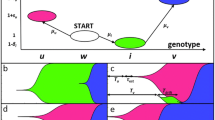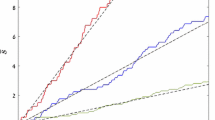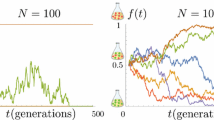Abstract
A simple stochastic model assuming continuous traits, normally distributed modifications, selection for fertility and multiplicative fitness was used to simulate phenotypic evolution by “reproducing individuals” in a given fitness landscape. Of particular interest was how small populations cross saddles separating distinct adaptive peaks. The simulated evolution exhibits a strong dualism: at the same level of reproductive errors, sexual reproduction provides significantly better local adaptation and asexual repreduction provides significantly better adaptive dynamics.
Similar content being viewed by others
References
Bernstein H, Hopf FA, Michod RE (1987) The molecular basis of the evolution of sex. Genetics 24:323–370.
Bremmermann HJ, Rogson M, Salaf S (1966) Global properties of evolution processes. In: Patecc HH, Edelsack EA, Fein L, Callahan AB (eds) Natural automata and useful simulations. Spartan Books, Washington, pp 3–41.
Bürger R, Wagner G, Stettinger F (1989) How much heritable variation can be maintained in finite populations by a mutationselection balance. Evolution 43:1748–1766.
Eigen M (1971) Self-organization of matter and the evolution of biological macromolecules. Naturwissenschaften 58:465–523.
Demetrius L, Schuster P, Sigmund K (1985) Polynucleotide evolution and branching orocesses. Bull Math Biol 47:239–262.
Eigen M (1985) Macromolecular evolution: dynamical ordering in sequence space. Ber Bunsenges Phys Chem 89:658–667.
Eigen M, Schuster P (1977) The hypercycle a principle of natural selforganization. Part A: Emergence of the hypercycle. Naturwissenschaften 64:541–565.
Eigen M, Schuster P (1978a) The hypercycle a principle of natural selforganization. Part B: The abstract hypercycle. Naturwissenschaften 65:7–41.
Eigen M, Schuster P (1978b) The hypercycle a principle of natural selforganization. Part C: The realistic hypercycle. Naturwissenschaften 65:341–369.
Eigen M, McCaskill J, Schuster P (1988) Molecular quasi-species. J Phys Chem 92:6881–6891.
Eldredge N, Gould SJ (1972) Punctuated equilibria: an alternative to phyletic gradualism. In: Schopf TJM (ed) Models in paleobiology. Freeman & Cooper, San Francisco, pp 82–115.
Felsenstein J (1979) Excursions along the interface between disruptive and stabilizing selection. Genetics 93:773–795.
Fontana W, Schuster P (1987) A computer model of evolutionary optimization. Biophys Chem 26:123–147.
Fontana W, Schnabl W, Schuster P (1989) Physical aspects of evolutionary optimization and adaptation. Phys Rev A 40:3301–3321.
Galar R (1985) Handicapped individua in evolutionary processes. Biol Cybern 51:1–9.
Galar R (1989) Evolutionary search with soft selection. Biol Cybern 60:373–364.
Galar R, Kwaśnicka H, Kwaśnicki W (1979) Simulation of some processes of development. In: Dekker L, Savastano G, Vansteenkiste (eds) Simulation of Systems '79, North Holland, Amsterdam, pp 133–142.
Holland JH (1975) Adaptation in natural and artificial systems. University of Michigan Press, Ann Arbor.
Kirkpatrick M (1982) Quantum evolution and punctuated equilibria in continuous genetic characters. Am Nat 119:833–848.
Kirkpatrick S, Gellat CD Jr, Vecchi MP (1983), Optimization by simulated annealing. Scinece 220:671–680.
Lande R (1985) Expected time for random genetic drift of a population between stable phenotypic states. Proc Natl Acad Sci USA 82:7641–7645.
Ludwig D (1981) Escape from domains of attraction for systems perturbed by noise. In: Inns RH et al. (eds) Nonlinear pheonmena in physics and biology. Plenum Press, New York.
Maynard Smith J (1978) The evolution of sex. Cambridge University Press, Cambridge.
McCaskil JS (1984) A stochastic theory of macromolecular evolution. Biol Cybern 50:63–73.
Muller HJ (1964) The relation of recombinational to mutational variance. Mutat Res 1:2–9.
Nowak M, Shuster P (1989) Error tresholds of replication in finite populations. Mutation frequencies and the onset of Muller's ratchet. J Theor Biol 137:375–395.
Roughgarden J (1979) Theory of population genetics and evolutionary ecology. MacMillan, New York.
Rouhani S, Barton NH (1987a) The probability of peak shifts in founder population. J Theor Biol 126:51–62.
Rouhani S, Barton N (1987b) Speciation of the “shifting balance” in a continuous population. Theor Pop Biol 3:465–492.
Schuster P, Sigmund K (1985) Dynamics of evolutionary optimization. Ber Bunsenges Phys Chem 89:668–682.
Simpson GG (1953) The major features of evolution. Columbia University Press, New York, pp 398–393.
Wright S (1932) The roles of mutation, cross-breeding and selection in evolution. Proceedings of the VI International Genetics Congress 1, pp 356–366.
Wright S (1977) Experimental results and evolutionary deductions. Evolution and the genetics of populations, vol 3. University of Chicago Press, Chicago, pp 443–473.
Author information
Authors and Affiliations
Rights and permissions
About this article
Cite this article
Galar, R. Simulation of local evolutionary dynamics of small populations. Biol. Cybern. 65, 37–45 (1991). https://doi.org/10.1007/BF00197288
Received:
Accepted:
Issue Date:
DOI: https://doi.org/10.1007/BF00197288




